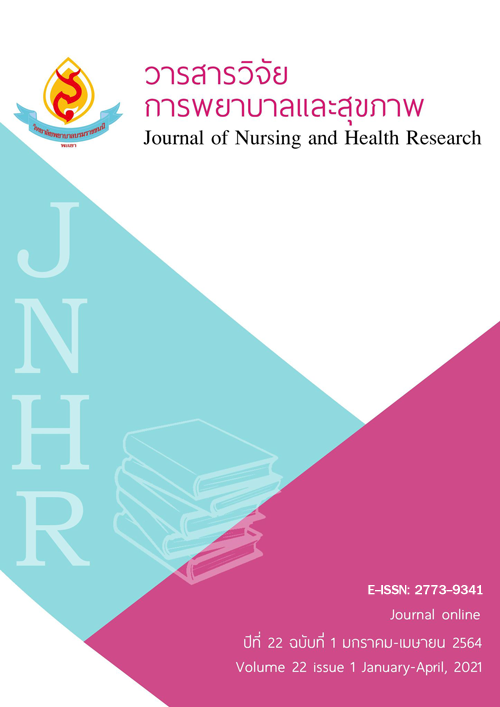ผลของการใช้นวัตกรรมหุ่นจำลองดูดเสมหะ“SNC.SUCTION MODEL” ต่อทักษะดูดเสมหะของนักศึกษาพยาบาล
คำสำคัญ:
นวัตกรรม, หุ่นจำลอง, ดูดเสมหะบทคัดย่อ
การวิจัยครั้งนี้เป็นการวิจัยกึ่งทดลองมีวัตถุประสงค์เพื่อศึกษาเปรียบเทียบทักษะดูดเสมหะของนักศึกษาพยาบาลศาสตร์ชั้นปีที่ 2 ที่เรียนรู้โดยใช้นวัตกรรมหุ่นจำลองดูดเสมหะ“SNC. SUCTION MODEL” และเรียนรู้โดยใช้หุ่นมาตรฐานทางการแพทย์ และความพึงพอใจของนักศึกษาพยาบาลศาสตร์ชั้นปีที่ 2 ต่อการฝึกทักษะดูดเสมหะโดยใช้นวัตกรรมหุ่นจำลองดูดเสมหะ“SNC. SUCTION MODEL” กลุ่มตัวอย่างเป็นนักศึกษาพยาบาลศาสตร์ชั้นปีที่ 2 วิทยาลัยพยาบาลบรมราชชนนี สุพรรณบุรี จำนวน 60 คน เลือกกลุ่มตัวอย่างแบบวิธีสุ่มแบบหลายขั้นตอน เครื่องมือที่ใช้ประกอบด้วย 2 ส่วน 1). เครื่องมือที่ใช้ในการทดลองได้แก่นวัตกรรมหุ่นจำลองดูดเสมหะ “SNC. SUCTION MODEL”และหุ่นมาตรฐานทางการแพทย์ และ 2). เครื่องมือที่ใช้ในการเก็บรวบรวมข้อมูลได้แก่ แบบประเมินทักษะการดูดเสมหะ จำนวน 5 ข้อ ค่าความเชื่อมั่นเท่ากับ .71 และ3). แบบประเมินความพึงพอใจของนักศึกษาพยาบาลศาสตร์ชั้นปีที่ 2 ต่อการฝึกทักษะดูดเสมหะโดยใช้นวัตกรรมหุ่นจำลองดูดเสมหะ“SNC. SUCTION MODEL” จำนวน 11 ข้อ ค่าความเชื่อมั่นเท่ากับ .82 วิเคราะห์ข้อมูลด้วยสถิติเชิงพรรณนาได้แก่ ความถี่ ร้อยละ ค่าเฉลี่ยและส่วนเบี่ยงเบนมาตรฐาน สถิติไคสแควร์และสถิติทดสอบที ผลการวิจัยพบว่าค่าเฉลี่ยคะแนนทักษะดูดเสมหะของกลุ่มทดลองที่เรียนรู้โดยใช้นวัตกรรมหุ่นจำลองดูดเสมหะ“SNC. SUCTION MODEL” มากกว่าค่าเฉลี่ยคะแนนทักษะดูดเสมหะของกลุ่มควบคุมที่เรียนรู้โดยใช้หุ่นมาตรฐานทางการแพทย์อย่างมีนัยสำคัญทางสถิติที่ระดับ .01 โดยค่าเฉลี่ยคะแนนทักษะดูดเสมหะของกลุ่มทดลองเท่ากับ 23.00 (SD=3.37) และค่าเฉลี่ยคะแนนทักษะดูดเสมหะของกลุ่มควบคุมเท่ากับ13.40 (SD=7.72) และพบว่ากลุ่มทดลองมีความพึงพอใจต่อการฝึกทักษะดูดเสมหะโดยใช้นวัตกรรมหุ่นจำลองดูดเสมหะ“SNC. SUCTION MODEL” อยู่ในระดับมากที่สุด โดยมีค่าเฉลี่ยคะแนนเท่ากับ 4.67 (SD= 0.25) ดังนั้นจึงควรนำหุ่นจำลองดูดเสมหะ“SNC. SUCTION MODEL” ที่พัฒนาขึ้นไปใช้ในการฝึกปฏิบัติของนักศึกษาในภาคทดลองก่อนที่นักศึกษาจะขึ้นฝึกปฏิบัติจริงบนหอผู้ป่วยเพื่อให้นักศึกษาสามารถปฏิบัติทักษะดูดเสมหะได้อย่างถูกต้องและผู้ป่วยปลอดภัย
เอกสารอ้างอิง
กัลยา เตชาเสถียร และสถาพร กลางคาร. (2556). การพัฒนาหุ่น Police Wound เพื่อฝึกทักษะการ จัดการบาดแผล. วารสารพยาบาลตำรวจ, 5(1), 45-54.
คณาจารย์เครือข่ายภาคกลาง 2. (2562). แบบประเมินทักษะการดูดเสมหะ(OSCE) เครือข่ายภาคกลาง 2. เอกสารอัดสำเนา.
ปรียสลิล ไชยวุฒิ และเยาวลักษณ์ คุมขวัญ. (2560). หุ่นจำลองฝึกทักษะการดูดเสมหะ: นวัตกรรมสื่อการสอนทางการพยาบาล. วารสารพยาบาลกระทรวงสาธารณสุข, 27( 2), 47-59.
รวิภา บุญชูช่วย. (2558). นวัตกรรมหุ่นฝึกทักษะการดูดเสมหะ “RTAFNC Suction Model”, วารสารพยาบาลตำรวจ, 7(1), 45-52.
เรืองวิทย์ นนทะภา และคณะ. (2547). สื่อและเทคโนโลยีการสอน. กรุงเทพฯ ภาควิชาเทคโนโลยีทางการศึกษา. เอกสารประกอบการบรรยายกระบวนวิชา 059400. มหาวิทยาลัยเชียงใหม่.
สุนทร โคตรบรรเทา. (2560). การบริหารการศึกษา: หลักการและทฤษฎี (ฉบับปรับปรุง). กรุงเทพฯ: สำนักพิมพ์ปัญญาชน.
สำนักคณะกรรมการการอาชีวะศึกษา. (2554). การประเมินคุณภาพสื่อการสอนและนวัตกรรม, สืบค้นเมื่อ 12 เมษายน 2562 จาก htpp://www.chontech.ac.th/fscommand/small book.pdf
อภินันท์ สุประเสริฐ. (2552). การวิจัยและพัฒนาหุ่นจำลองอวัยวะภายในมนุษย์ด้วยยางพาราและการต่อยอดเชิงพาณิชย์. (รายงานการวิจัย คณะสัตวแพทยศาสตร์). กรุงเทพฯ. มหาวิทยาลัยเกษตรศาสตร์.
Best, J. W. (1981). Research in Education (4 th ed). New Jersey: Prentice–Hall Inc.
Cohen, J. (1977). Statistical power for the behavioral sciences. 2nd ed. New York: Academic Press.
Jeffries, P. R., & Clochesy, J. M. (2012). Clinical simulations: An experiential student-Centred pedagogical approach. In D. M. Billings and J. A. Halstead (eds), Teaching in ์ursing: A guide for Faculty 4th ed, (pp, 352-68). St Louis MO: Sauders Elsevier.
Kasatpibal, N., Sawasdisingha, P., & Whitney, J. D. (2016). Innovation of educational wound models for nursing students. Journal of Nursing Education and Practice, 6(9): 101-109.
Luctker-Flude, M., Wilson-Keates, B., & Larocque, M. (2012). Evaluating high-fidelity human simulators and standardized patients in undergraduate nursing health assessment course. Nursing Education Today, 32(4), 448-452.
Mullins, L. T. (1985). Management and organisational behaviour. London: Pitman.
Ricketts, B. (2011). The role of simulation for learning within pre-registration nursing education: A literature review. Nurse Education Today, 31(7), 650-654.
Susanha, Y. (2015). Developing simulation model for training clinical skill of health science students. Nursing Journal, 43(2): 142-151.
Wongprach, B. & Poomsanguan, K. (2017). Innovation development of the Army Nurse Condom Ring for male patient: Applying a drainage condom. Journal of The Royal Thai Army Nurse, 19(1), 55-65.
ดาวน์โหลด
เผยแพร่แล้ว
รูปแบบการอ้างอิง
ฉบับ
ประเภทบทความ
สัญญาอนุญาต
ลิขสิทธิ์ (c) 2021 วารสารวิจัยการพยาบาลและสุขภาพ

อนุญาตภายใต้เงื่อนไข Creative Commons Attribution-NonCommercial-NoDerivatives 4.0 International License.



